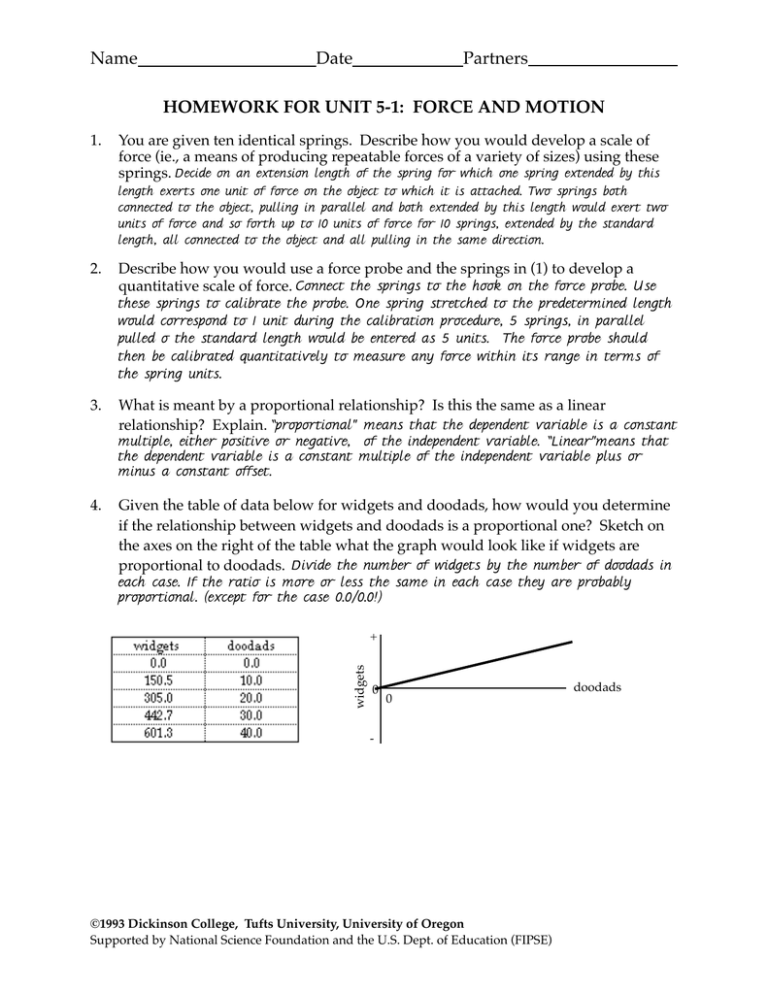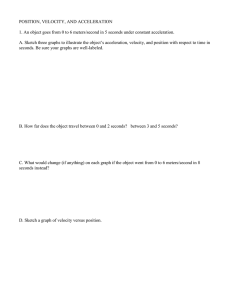Force and Motion Homework: Springs, Graphs, and Relationships
advertisement

Name Date Partners HOMEWORK FOR UNIT 5-1: FORCE AND MOTION 1. You are given ten identical springs. Describe how you would develop a scale of force (ie., a means of producing repeatable forces of a variety of sizes) using these springs. Decide on an extension length of the spring for which one spring extended by this length exerts one unit of force on the object to which it is attached. Two springs both connected to the object, pulling in parallel and both extended by this length would exert two units of force and so forth up to 10 units of force for 10 springs, extended by the standard length, all connected to the object and all pulling in the same direction. 2. Describe how you would use a force probe and the springs in (1) to develop a quantitative scale of force. Connect the springs to the hook on the force probe. Use these springs to calibrate the probe. One spring stretched to the predetermined length would correspond to 1 unit during the calibration procedure, 5 springs, in parallel pulled o the standard length would be entered as 5 units. The force probe should then be calibrated quantitatively to measure any force within its range in terms of the spring units. 3. What is meant by a proportional relationship? Is this the same as a linear relationship? Explain. “proportional” means that the dependent variable is a constant multiple, either positive or negative, of the independent variable. “Linear”means that the dependent variable is a constant multiple of the independent variable plus or minus a constant offset. 4. Given the table of data below for widgets and doodads, how would you determine if the relationship between widgets and doodads is a proportional one? Sketch on the axes on the right of the table what the graph would look like if widgets are proportional to doodads. Divide the number of widgets by the number of doodads in each case. If the ratio is more or less the same in each case they are probably proportional. (except for the case 0.0/0.0!) widgets + 0 0 - ©1993 Dickinson College, Tufts University, University of Oregon Supported by National Science Foundation and the U.S. Dept. of Education (FIPSE) doodads Page H4-2 V1.21β--8/11/93 Real Time Physics: Active Learning Laboratory Acceleration 5. A force is applied which makes an object move with the acceleration shown below. Assuming that friction is negligible, sketch a force-time graph of the force on the object on the axes below. + 0 - Force + 0 - 0 1 2 3 Time (sec) 4 5 Explain your answer: Force and acceleration are proportional 6. Roughly sketch the velocity-time graph for the object in question 5 on the axes below. 7. A cart can move along a horizontal line (the + position axis). It moves with the velocity shown below. © 1993 Dickinson College, Tufts University, University of Oregon Supported by National Science Foundation and the U.S. Dept. of Education (FIPSE) Real Time Physics: Homework for Lab 4: Force and Motion Authors: David Sokoloff , Ronald Thornton & Priscilla Laws Page H4-3 V1.21β--8/11/93 Velocity + 0 0 3 Time (sec) 5 4 Assuming that friction is so small that it can be neglected, sketch on the axes that follow the acceleration-time graph of the cart's motion. + Acceleration 2 1 0 0 2 Time (sec) 3 4 5 0 - 1 Sketch on the axes below the force which must act on the cart to keep it moving with this velocity and acceleration. (Remember that friction is negligible.) + Force 0 1 2 3 4 5 Time (sec) Explain both of your graphs. If velocity is constant then acceleration is zero. Zero acceleration implies that the net force is zero. Questions 8-10 refer to an object which can move in either direction along a horizontal line (the + position axis). Assume that friction is so small that it can be neglected. Sketch the shape of the graph of the force applied to the object which would produce the motion described. ©1993 Dickinson College, Tufts University, University of Oregon Supported by National Science Foundation and the U.S. Dept. of Education (FIPSE) Page H4-4 V1.21β--8/11/93 Real Time Physics: Active Learning Laboratory + Force 8. The object moves away from! the origin with a constant ! velocity. 0 Time + The object moves toward the! origin with a constant velocity. Force 9. 0 Time + Force 10. The object moves away from the ! origin with a steadily increasing! velocity (a constant acceleration). 0 Time + Velocity Questions 11-12 refer to an object which can move along a horizontal line (the + position axis). Assume that friction is so small that it can be ignored. The object's velocity-time graph is shown on the right. 0 0 1 2 3 Time(sec) 4 5 11. Sketch the shapes of the acceleration-time and force-time graphs on the axes below. © 1993 Dickinson College, Tufts University, University of Oregon Supported by National Science Foundation and the U.S. Dept. of Education (FIPSE) Real Time Physics: Homework for Lab 4: Force and Motion Authors: David Sokoloff , Ronald Thornton & Priscilla Laws Page H4-5 V1.21β--8/11/93 Acceleration + 0 Force + 0 - 0 2 1 3 Time (sec) 5 4 12. Suppose that the force applied to the object were twice as large. Sketch with dashed lines on the same axes above the force, acceleration and velocity. + Velocity Questions 13 refers to an object which can move along a horizontal line (the + position axis). Assume that friction is so small that it can be ignored. The object's velocity-time graph is shown on the right. 0 0 1 2 4 3 5 Time(sec) - 13. Sketch the shapes of the acceleration and force graphs on the axes below. Acceleration + 0 Force + 0 - 0 1 2 3 Time (sec) 4 ©1993 Dickinson College, Tufts University, University of Oregon Supported by National Science Foundation and the U.S. Dept. of Education (FIPSE) 5 Page H4-6 V1.21β--8/11/93 Real Time Physics: Active Learning Laboratory © 1993 Dickinson College, Tufts University, University of Oregon Supported by National Science Foundation and the U.S. Dept. of Education (FIPSE)

